|
"We are all Reformers
here," wrote Christian Ramsay, later Wright, to her young brother John
in a letter describing the political, social and family activities in
the Alloa household of her Aunt Kirsty. The Reform Bill (to be passed in
1832) was a prime topic for discussion in 1831 and Aunt Kirsty led the
Ramsay contingent in its favour.
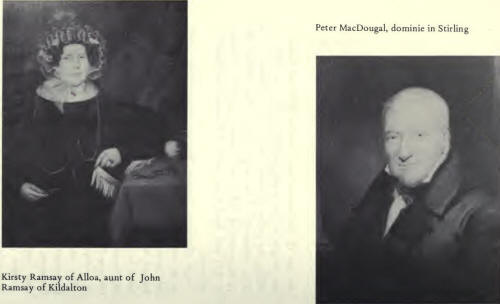
Aunt Christian Ramsay
(known always in the family by the old Scots abbreviation of Kirsty) was
a redoubtable woman, who had rescued the family finances when Robert,
her eldest brother and father of Christian and John, let slip from his
loose grasp the malting and distilling business built up by his father,
Thomas Ramsay, and his grandfather Ebenezer Morrison. The Ramsays were
an independent lot, possessed of flaring, though not sulky, tempers;
proud of their lineage, descended from Dalhousie and kin to the
Sterlings, Morrisons, Erskines, Grahams, Mitchells and Stems. Moreover,
as a family they maintained a tradition of reform. In earlier
generations they had "suffered" for the Reformed Church in Scotland and
fought in the army of the Covenant; later, in 1747, they had followed
the Reverend Ebenezer Erskine in the split of the Secession Church and
later still, in 1843, they were to walk out of the General Assembly of
the Church of Scotland with Dr. Thomas Chalmers to assist in the
founding of the Free Church of Scotland.
John Ramsay, the youngest
son in a family of seven, was born on August 15, 1815, exactly two
months after the Battle of Waterloo. To the end of his days he retained
a vivid memory of watching, as a small child, from the windows of one of
the tall Stirling houses, the last public hanging in Scotland. The
victims, Baird and Hardie, belonged to a movement which bound its
members by the "Glasgow Oath" to endeavour "to obtain either by moral or
physical strength as the case may require for all persons, not
disqualified by crimes or insanity, the elective franchise at the age of
twenty-one". When they marched towards Edinburgh to dramatize their
cause, armed with pikes and agricultural implements, they were arrested
by the military, convicted of treason and sentenced to death. Admitting
that the authorities were still fearful of the possible effects of the
French Revolution, nonetheless the Ramsay family were staunch supporters
of the Electoral Reform Bill which, twelve years later, was to be a
fitting memorial to the unfortunate weavers. In after years, the
impression made by this event fired John's interest in politics and he
gave his youthful admiration to Sir Robert Peel, whose great
statesmanship remained an inspiration throughout his life.
John and his two brothers
were educated in Stirling under the famous dominie, Peter MacDougall,
spending much of their time with their Grandfather Stirling at
Craigforth. He was a progressive farmer, a highly successful breeder of
cattle, and his influence, like MacDougall's, was to be very evident in
John's later life.
By 1828, Thomas, his
eldest brother, was shipbuilding in Miramachi, New Brunswick. William,
the second brother, who was delicate and would marry and die within a
few years, lived with his uncle Alexander Ramsay, who farmed at Overton,
near Alloa. Young John, sensitive, with the quick temper of the redhead,
and very intelligent, was not content after the death of his mother and
grandfather Stirling to remain a recipient of his Aunt Kirsty's bounty
and at the age of twelve he rode off through the January snow to seek
his fortune in Glasgow.
There he was welcomed by
a maternal aunt and her husband, Peter Maxton. He first obtained work in
a mill at Balfron, which he hoped might lead to his becoming an
engineer. In fact, it held no such prospect and he shortly gave it up to
become clerk at Mr. White's cotton mill in Eaglesham, Renfrewshire, at a
weekly wage of fifteen shillings.
There is a most revealing
little account book, meticulously kept in a fine copperplate hand from
the moment he started work there in March, 1828. It recounts that he
paid three shillings a fortnight for his lodgings and bought all his own
provisions. A typical entry reads,
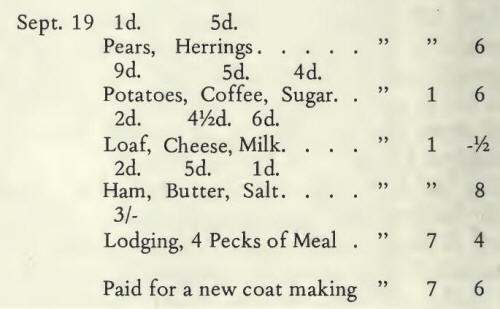
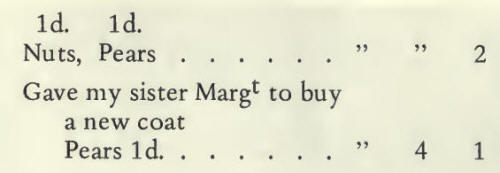
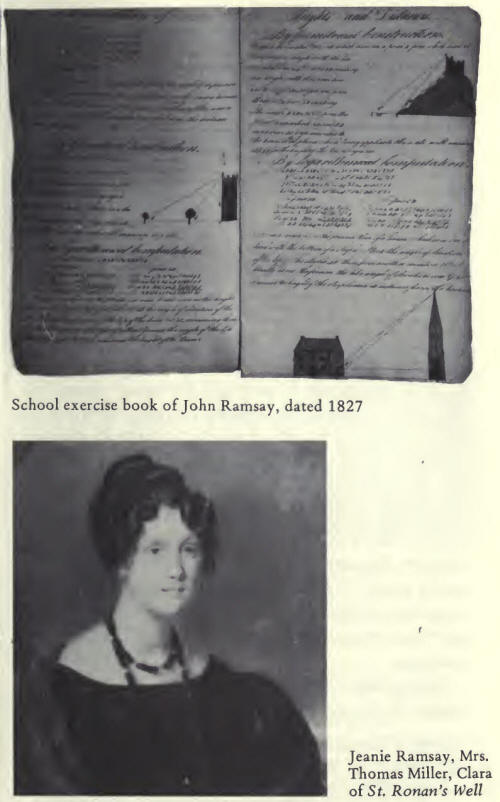
He paid Mr. Laidlaw "for
teaching me Latin, 7/-" and quarterly subscriptions to the reading club
and lending library of 1/1. Although he was careful, he was also
generous and there are many entries of gifts to his sisters and "a ring
for Aunt"; toys for his young cousins in Glasgow and for the children of
his eldest sister Janet, Mrs. Pender, who lived in Falkirk. To visit her
he travelled "by boat, 3/- (the Forth-Clyde Canal, sometimes getting a
lift on to Alloa in the Earl of Mar's coach, for which he would tip the
coachman a shilling. It cost 8/6 by mail coach to Edinburgh to visit
another sister, Jeanie, Mrs. Miller (immortalized, says family
tradition, by Sir Walter Scott as Clara in his "modern" novel St.
Ronan's Well). His father "took a loan of 5s." on July 22, 1829, and in
May the following year an entry reads "gave my father to buy clothes to
take him to England, £1. 15. 0." and to a "poor soldier's widow to help
her to go to America, 6d." while on January 30 he enjoyed himself at "a
curling match played by candlelight" for the cost of 7d. He seems also
to have done casual work as he records receiving "from Hospital £5."
presumably for clerking or accounting.
Thomas wrote to him from
New Brunswick, congratulating him on having found work. He continues,
I am very sorry that
trade is so dull with you as it is likewise very dull here, although
the poorer class is not quite so bad as with you as they mostly have
a small house of their own and thereby need pay no rent which is a
great help for them. About the place I can give you but a very poor
description of it as I could hardly describe it so [you] may form
any idea of it as you can see nothing here but only burnt woods
since the dreadful fire and before only green woods. As for myself I
am still working in Mr. Abram's shipyard at present who is still
carrying on ship-building though trade is very dull....
Thomas had made a trip
home in 1830, leaving, on his departure, £26 in the hands of his cousin
Thomas Ramsay, for John. Cousin Thomas promptly offered John 4% on the
money "if I allow it to ly with him which I think to do until my brother
[Thomas] comes home".
John's interest in
education was already marked and there still exists an essay which he
wrote for a political club, in which he especially advocated the need
for the education of women. He managed to attend Latin classes at the
University of Glasgow and to read History with the aim of entering the
Law. But, as a result of making enquiries on his behalf in Edinburgh,
his brother-in-law Thomas Miller, advised him that there were too many
young men aspiring to this end and that it cost too much to be articled
to a lawyer. John looked at his profit and loss account and read:
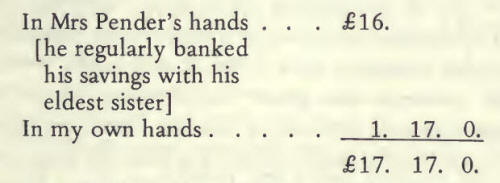
So, perforce, he turned
his eyes elsewhere.
On April 14, 1831, John
saw his father sail for Montreal, Lower Canada. There, for a number of
years, Robert worked as a saddler, building up a thriving business not
only in the city but also in the surrounding country.
Canada at this time,
apart from the Maritime Provinces, was divided into Upper and Lower
Canada. The latter had been settled by the French in the seventeenth
century and, though surrendered to Britain, remained a religious and
linguistic entity, deeply conscious of its origins and traditions; the
former had been settled mainly by those of British blood who could not
stomach republicanism and had cut their losses in the new United States,
crossed the border and proceeded to carve out of the Ontario bush
another colony for Britain. These two colonies, incompatible in many
ways, together repelled the American invasion of 1812-14, but by the
eighteen thirties differences had arisen between them. The French
Canadian residents of Quebec resented the privileges and power enjoyed
by the English-speaking minority in their province. When these English
merchants and professional men promoted a bill which would unite the two
provinces, giving greater representation to non-French areas and
eliminating French as a language of government, there was an outcry
against "les Anglais" and British immigrants found themselves unpopular.
The residents of Upper Canada, though glad to have their land values
raised by an influx of British immigrants, nevertheless resented the
political viewpoint which they introduced and refused to acknowledge
them as equals. "Old Country folk" were, therefore, personae non gratae
for different reasons in both provinces, and provided a butt for the
native-born in each, in two short, simultaneous, but quite separate and
unsuccessful rebellions at the end of 1837. Robert, living at 63 St.
Antoine Street, Montreal, wrote a graphic, breathless account to his
brother David in Scotland.
There is no doubt but
that you have heard that this country has been in a steat of
rebellion for this some time past and how it is to end no one can
tell for all though it is subdued at present the spirit of it is
still remaining unaltered in the great body of the Canadians and
although they are crying out for the Queen and Loyalty yet when they
have it in their power they act to the contrary when they fall in
with a single one or two of the Old Country folks as they call them
But no such spirit shews itself here [Montreal] as almost every man
here is a soldier - of British extraction I mean. The Rebels made
their first trial of strength here in the City on the 6th November
when they had a meeting to lay their plans When a few of the Old
Country folk had collected outside to hear pairt of what was going
on the Canadans seeing them few in number at the conclousion of
their meeting thought proper to attack them in the Street with
sticks and stones and whatever they could lay their hands on when
the Old Country folk were forced to retreat for a little way When
there Brethren hearing of the matter ran from all quarters to their
assistance when they drove back their oponents with many brocken
heads and their General a T.S. Brown was prity much hurt and had it
not been for a Mr Gunluck and a Mr Ashton he would have been much
more so for they were just in time to save him for his antagonists
were too much for him so they got him to a Doctrs house that was
just at hand Some say it was a pity he got off as their is now £500.
offered for him. Next about 500 attacked with firearms 18 Caviery
who were escorting two prisoners to town They lay in ambush for them
and fired on them rescued the prisoners and wounded two of the
Cavlery and a third a Mr J. Molson had a ball through his cap taking
part of the hair with it but was no otherways hurt and I believe
they were all in the Field of Battle in a few days after Troops
being sent to a place called St Denis and another party being sent
to St Charles where the rebels had collected with their leaders at
their head with cannon and plenty of the munitions of war Both
places being in the same direction the Troops taking different routs
Lieut Weir of the 32nd Regiment was sent with Despatches from
Montreal but not being acquainted with the roads he was taken into
St Denis to the Rebel Camp and made prisoner The Rebels hearing the
Troops were coming upon them bound and sent him for St. Charles with
a gaird They had not proceeded far on their road when his guards
fell upon him and murdered him in too shocking a manner to repeat It
is said that they have now got all his murderers in prison. His
corps was afterwards brought to Montreal for interment when not less
than 8,000 attended his funeral One would have thought that the
whole city was in mourning and so much was he lamented that shops
Taverns and stores of all kinds belonging to the Old Country people
was shut up for a time that is to say for the afternoon. Another of
these Rebels was binding a Loyalt to a tree and shooting at him as
they would a cock After a few days the troops attacked the band at
St Charles routed and killed a great many of them and brunt a great
part of the place. They were next drove from St. Denis and a good
pairt likewise brunt Had they been at all successful the Canadan
population was to rise in mass and kill all Old Country Folks and
drive them into the St. Lawrence and seize their property They
calculated on victory and considered that all was their own and
their was between 2000 [the paper here is badly torn] collected to
the North of the City ready to come on with [again the paper is torn
here] but thanks be he who is the God of Battles gave it against
them In the morning our enemies were crowing as it wer over us but
when the news arrived in the afternoon they quickly disappeared from
the street but they still had hop of success as the band to the
North had got themselves entrenched at three different points and
all Old Country people had to flee for their lives and leave their
property behind them. They were attacked in their strongholds
completely routed and a great many killed and many more brunt to
death in the Church and houses where they had posted themselves That
was at a place called St. Eustach. The Troops then went to Grand
Boule and St Benoit which gave in without firing a shot but both
places were brunt to the ground with pairt of the Bell River and St.
Coulastich they all being a nest of Rebels and had committed plunder
over a great part of the Country around them but it is impossible to
say how many lost their lives but their Families now begin to see
that they want a Father or son and a gentim who lives between St.
Eustach and Grand Boule informed me the other day that there was 56
wanting in his neborhood which are all supposed to have gone to
their long homes. There is Rebellion likewise in the Upper Province
but it is thought that it will be put down with less loss of life if
the Americans were withdrawn from the Rebel ranks and the great fear
is that their interference will bring on War between the two
countries but it is hoped it will not But the Americans cry out
against our people for capturing a steam boat which was imployed by
the Rebels if not belonging to them altogether with was imployed in
carrying arms provisions etc. for their camp in sight of our peoples
on the opposite shore. They attacked her brought her from her
moorings and sent her over the Falls of Niagra. We have an account
of a schooner being taken at Amhurstburg loaded with 400 stand of
arms and 3 cannons and a large supply of munitions of war that they
had robbed at Detroit and were taking them to the Rebels. They had
fired on the Town The inhabitants had no arms but they collected
pitchforks and what they could lay their hands on attacked her
killing one man and taking 20 prisoners So much under Providence for
Valour. The Weather (sic) from Kingston on Saturday last say the
weather made navigation open as in Summer The River here is higher
that I ever seed it this day and it appers it has done a great deal
of damage in the Town Make my best respects to Mr MacLean [a partner
of Messrs Dow & Co., Distillers, Montreal, who appears to have been
visiting Scotland at this moment: he was Robert's great friend and
adviser during his life in Canada] Wishing you all again many happy
returns of the season.
I remain
Yours truly
ROBt RAMSAY
I have been at this
[Montreal] now this fourteen nights past now and again The capture
of the schooner came on Saturday last and the river is over St.
Antoine Street by Mr Watsons and no pas- sage on foot much damage
done let Mr McLean know.
The letter is dated "1837
Janry 22," but the Montreal postmark is "Ja 23 1838". It travelled via
New York, the stamp for that city being "Jan 29" and the receiving date
at Leith is "Feb 28 A 1838". Robert had obviously made a New Year
clerical error!
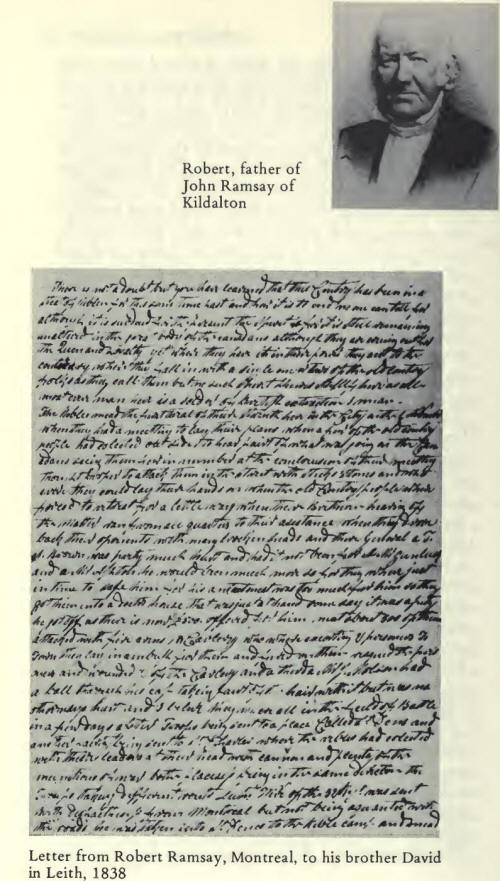
In 1851, Robert was
married again, this time to Ann MacLennan of Lachute, Canada East, where
he had
acquired a farm. Alexander Stirling, a brother of his first wife,
visited him there and was later drowned negotiating a nearby river.
Robert died in September, 1857, at the age of eighty-four, and was
buried in the Presbyterian graveyard at Lachute.
Meantime, in Scotland,
young John was casting round for a better job and was, in fact,
considering offers of employment in both South Africa (Natal) and India
when two things happened: firstly, his Uncle James Ramsay, a merchant in
New Orleans, came home and half promised to take him back to the States;
secondly, because of a family interest in the Port Ellen Distillery,
Isle of Islay, off the west coast of Argyll, he was sent there by his
Uncle Ebenezer Ramsay (Procurator Fiscal of Clackmannanshire) to report
on its management, which seemed unsatisfactory. The distillery had been
developed from a malt mill erected in 1825 by Alexander Kerr MacKay and
managed by a mutual kinsman, John Morrison from Alloa. The Fiscal had
already sent his young son Eben for this purpose, but had received no
word from him.
Owing to contrary winds,
John Ramsay was landed at Glenchoiredail near McArthur's Head on the
Sound of Islay. He had to make his way across the roadless eastern part
of the island to Port Ellen. The distance as the crow flies is only
about twelve miles, but on foot, through an unfamiliar wilderness of
deep glens, rockbound hills, treacherous bog and heather moor, it was
very considerably longer. The compass that he used to guide him on this
occasion is still in the family's possession. Near Arivochallum he
encountered one of the MacDougalls, who loaned him a white pony to carry
him over the last few miles of the journey.
On arrival he found that
Eben had already sailed for home, bearing ill tidings of affairs at Port
Ellen. John, however, was convinced that the distillery could be made to
pay and wrote his uncle accordingly. Eben, refusing to have anything to
do with it, was carried off (to John's great chagrin) by Uncle James to
New Orleans.
At this juncture, Thomas
Ramsay, John's eldest brother, arrived home from New Brunswick and it
was finally agreed that John should go to Alloa for initiation into the
art of distilling by James, a brother of John Morrison, and should then
manage the Port Ellen Distillery at an annual salary of E150, while John
Morrison would sell the product in Glasgow and Thomas would be
responsible for purchasing the necessary grain. It was soon evident that
John Morrison was an impossible partner and Thomas threw his hand in,
crossed the Atlantic once more and was believed to have lost his life in
the Mexican War of 1836-37. The situation was saved by Major Adair, a
peg-legged veteran of Waterloo, who, having taken a liking to John
Ramsay, purchased the remaining years of the ground lease. The second
son of the Fiscal, another Thomas Ramsay, now became a partner and John
Morrison was excluded. Later John Morrison was installed in Ardinistle
Distillery on the island, only to fail again and return to Glasgow an
embittered man. The Glasgow agency was given to Mr. J. Richardson, who
held it for many years.
In 1840, Walter Frederick
Campbell of Shawfield and Islay, also much impressed by John's integrity
and ability, exercised his right of preemption at the expiry of the
lease, following the death of Major Adair, and purchased the distillery
for £1,950, which equalled the highest bona fide bid, made by Alexander
Craig of Wadeston Mills, Glasgow. Reimbursed by John for this amount,
Walter Frederick had a completely new lease made out in John's name;
also a lease for the farms of Cornabus and Kilnaugh ton on the neck of
land connecting the peninsula of the Oa to the mainland of Islay - a
part of the lands granted to Brian Vicar MacKay by Donald, Lord of the
Isles, in the Gaelic Charter of 1408, one of the treasures of the
Register House, Edinburgh.

John was now twenty-five
years old and the proprietor of his own business. From this time he and
his distillery prospered. His sister Margaret came to keep house for him
at Cornabus, which he slated and modernized. It was, in fact, the first
house in Islay to have a water closet. So effective were his farming
methods that James Johnston, a leading agriculturalist of the day,
called the attention of the Islay tenants to Cornabus in a letter dated
October 26, 1845, in which he pointed out that a large area of bogland
on this farm had been very successfully drained. John was also the first
to cultivate turnips in the parish. His farm statement at the end of ten
years is of especial interest, being, as far as is known, the earl- jest
detailed account of a modern farm in Islay. Generations of progressive
farmers, Stirlings and Ramsays, in the Carse of Stirling, had bequeathed
to him a deep love and an instinctive feeling for the land, and his
early upbringing among them, added to his own intelligent observation,
had shown him the methods best suited to its improvement. For many years
he was to be a well-known contributor of articles on agricultural
subjects to the Glasgow Herald, under the pseudonym of "Scottish
Farmer".
Later, brother and sister
were joined by another sister, Jeanie, Mrs. Miller, whose husband and
infant daughter had died in one of the recurrent epidemics of fever
caused by the faulty plumbing of the modern sanitary system in the New
Town of Edinburgh.
At this same period the
Ardinistle Distillery was run by two brothers, James and Andrew Stein,
of another noted distilling family in Clackmannanshire, which was
closely related to the Ramsays. This distillery had been known, at
different times, as the Islay and the Kildalton Distillery; its
buildings are now incorporated in the office block and bond houses of
Laphroaig Distillery.
James Stein married
Margaret Ramsay in 1848 and became John's manager at the Port Ellen
Distillery, building the charming house on the edge of the village which
they called Rosalind Cottage. It is now known as Tighcargaman, a
misspelling of the original quarter land of Tighcarmagan, on which both
it and Port Ellen stand. This arrangement allowed John to concentrate
more on the mainland end of his business and entailed his being much in
Glasgow, where he had a house in Madeira Court. This property he later
sold to his future father-in-law, George Martin, who in turn sold it to
the London, Midland and Scottish Railway as part of the site of the
present Central Station.
During these years all
the Ramsay uncles and aunts had died. John Ramsay inherited a certain
amount of capital, which made it possible for him to extend his business
very considerably. He imported Sherry and Madeira wine (the casks used
for these wines were considered beneficial for the maturing and
colouring of whisky) and he was already exporting a large proportion of
the Port Ellen output to the United States. The spirit safe which he
invented was later adopted by the Customs and Excise and is still in use
in every Scottish distillery. As a leading distiller, he was largely
instrumental in obtaining duty free warehouses for maturing whisky. The
earliest of these is still in use at Port Ellen. It was considered to be
the finest maturing warehouse in Scotland but it has since been
heightened and this may, possibly, have altered its character.
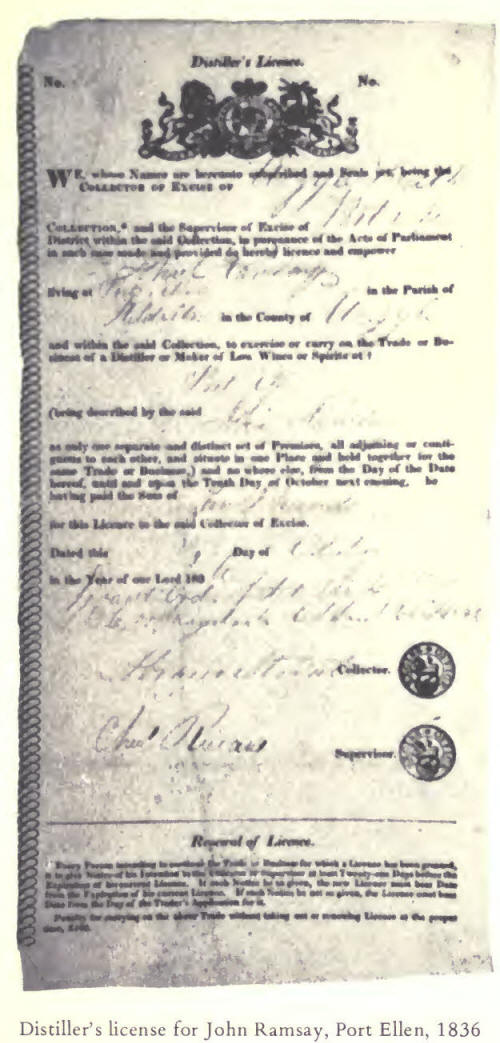
A great friendship had
grown up between the Ramsays and the Campbells of Islay. The laird,
Walter Frederick Campbell, who had made it possible for John Ramsay to
purchase the distillery, had come to rely on the younger man's advice
and opinions. Unfortunately they came too late. For a century and a
quarter the Campbells had striven against traditional prejudice to
improve and modernize the island by introducing new methods of farming,
building farmsteadings and villages, and endeavouring to start up light
industries. The years of internal peace and comparative plenty since the
Rebellion of 1745 along with an influx of labour on the reopening of the
lead mines and the introduction of the kelp industry (the burning of
seaweed to produce potash), had all vastly increased the population,
from approximately five to fifteen thousand. This increase produced the
further problems of inbreeding and its attendant ills. Added to all this
was the muddled incompetency of the factor, on whose financial
statements the laird relied.
At the request of Walter
Frederick Campbell, John Ramsay went through the ill-kept estate
accounts with the factor, but his findings only emphasized the sorry
financial position.
To understand the
attitude of the people it is necessary to know the old Highland setup
prior to the eighteenth century, whereby the chief gave to cadet
(junior) branches of his family a "tack", or indefinite lease (usually
unwritten) of land, for which they paid silver (money) rent, rent in
kind, and a quota of armed men when required. The tacksmen, thereupon,
sublet the land to lesser men of the clan who, in their turn, employed
crofters to work it for them, giving them a site for their cottages, cow
land and a proportion of the crop. Thus, this third class of people
received no wages and paid no rent. By preference, the families of the
tacksmen engaged in military pursuits, often enlisting as mercenaries in
the armies of the continent when not required for clan warfare at home.
They were followed by the men of the subtenants and the able-bodied
youth from among the crofters, whose greatest ambition was to excel as
warriors. Sometimes younger sons would engage in trading ventures. The
net result was that the land was worked in a very primitive manner by
the less able men and the women at their own time and speed.
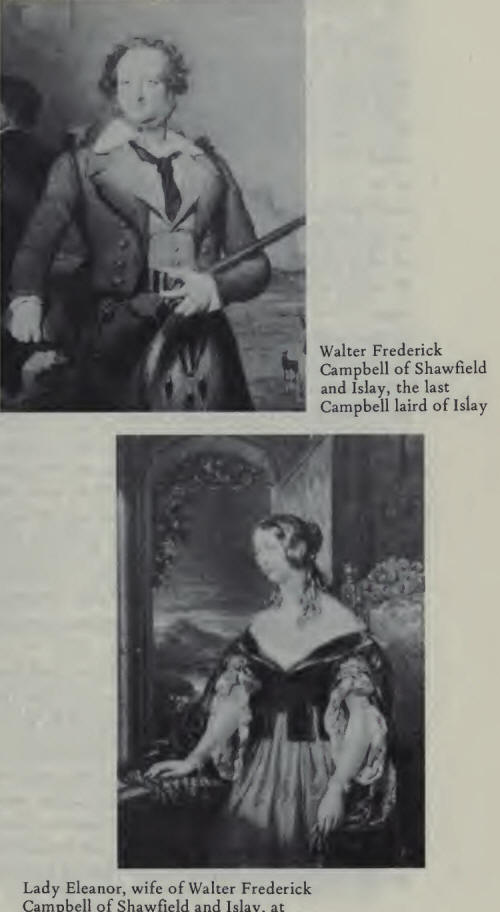
After the Rebellion of
1745, a steady stream of tacks- men's families, often accompanied by
their subtenants, emigrated to the New World or joined the British or
East India Company's armed forces. In 1738-39-40, over four hundred
people left Islay for the New England colonies. Thus the static
population of the island continued to be the crofters. The Shawfield
plan was to elevate the more promising of these to the state of tenant
farmers and to guide others into light industries, so that the burden of
over population might be lifted from the arable land. At no time in
their history had these crofters worked for wages, their time had been
their own, and, because of the frequent absences of their superiors,
they had come to look on the land as theirs. Though this gave them an
independence of spirit, it certainly was not conducive to their
acceptance of modern leases for fixed periods and stated rents, with
provisions against subletting; nor did they favour regular work for
wages in the various light industries which were introduced. They were,
moreover, almost entirely Gaelic-speaking and largely uneducated, which
made them slow to accept modern concepts of progress and contemporary
thought. The result was that they remained on the land in greatly
increasing numbers, subdividing it more and more as sons and grandsons
grew up.
So, to a large extent,
the population explosion had nullified the schemes for improvement. By
1846, with uneconomic lead mines, the collapse of the kelp industry due
to the importation of Spanish barilla after the Napoleonic Wars, a
series of exceedingly wet years which had brought disease to their
staple food, the potato, and ruined the cereal crop, and also because
the market price available for their cattle had dropped considerably,
the people reached starvation level. The laird and his more prosperous
tenants did all they could, but the following year they had to apply to
the Highland Relief Committee, hastily set up for the express purpose of
giving aid to the stricken areas. The following letter from John Ramsay
to the secretary of the committee, vividly presents the case for Islay.
Having heard that Dr
Boyter has been in Islay to report to your Committee the state of
the Island, I take leave to call attention to our case, as I regret
to learn that Dr Boyter was only a short time here and may possibly
not bring it in this way under your notice.
During the past
season of suffering and privation the proprietor and tenants of
Islay, feeling that it was of paramount importance at such a time to
cherish a feeling of independence have from their own private
resources given employment to the people on useful and advantageous
works throughout the Island without applying to your Committee
except to a very limited extent for their aid. Much has been done
and many sacrifices made for the support of the people and for the
encouragement among them of habits of industry. The resources of the
people are now, however, exhausted and there is great reason to fear
that the crops grown this year will be quite inadequate for the
support of the inhabitants of Islay, and it is therefore a subject
for anxious consideration to see how this shortcoming is to be
supplied.
One of the works
carried on to employ the people and to prevent them suffering from
want of food, is the formation of a road [the present high road
between Bridgend and Port Ellen], through a district of country held
chiefly by small tenants, the land being mostly waste though very
capable of improvement. .On this work an expense of labour has
already been incurred of not much under £1,000. Indeed I believe the
expenditure now exceeds that sum, though one half of the line is not
yet finished and the part that is done is not available as the
outlets from it to the present main road have not been touched. I
know of nothing more important to promote the prosperity of the
large population living in the district which this road passes
through than its early completion, for as the existing roads are not
only very circuitous (at times I believe quite impassable) the
people are shut out from the markets for their produce and prevented
from going on with that system of cultivation which alone in their
circumstances can render them independent. The quantity of potatoes
grown on their holdings in this year is not near enough to support
their families and already I regret to say there is a general
complaint of their partial failure. The name given to the district -
Canada - indicates that the population consider themselves shut out
from the more fertile districts of the Island.
My object in
addressing you is to solicit that you will bring the matter under
the notice of your Committee and obtain a grant to finish the road
with the necessary works connected with it, and this will require a
sum of not less than £1500 to £2000: in doing so the Committee will
confer a great benefit on the people of the district and indeed on
the whole Island.
I don't know that I
require to urge any argument in support of our claim, I might with
justice appeal to the exertions made by the proprietor and the
tenants to get on without support as one of the best reasons why the
Committee should aid us now that our own resources are exhausted and
as a large sum is still at your disposal, I trust that we may
receive the most favourable consideration.
if my views should
meet with your approval I would suggest if I may take leave to offer
an opinion on this point that the Committee request Dr Boyter to
revisit the Island and examine the merits of the case. I feel
assured that anyone when on the spot will in the circumstances
second my request, and to prevent the possibility of any
misunderstanding as to the proper expenditure of the money, the
Committee could not do better than appoint a qualified person to
superintend operations and pay out the money.
There is another work
of importance to the Island to which the Committee should agree to
allow Dr Boyter to examine our claims, I would respectfully direct
attention viz, the improvement and increase of the quay
accommodation at Bowmore. I am not prepared to state what sum would
be required to accomplish this, but a minute examination and
measurement may be made when Dr Boyter is on the spot and from this
the Committee would judge of the propriety of granting funds,
When I had the
pleasure of seeing you I had hoped that no such application as this
would be necessary: but since my return home I have been through the
district (the poorest in the island) I have referred to, and having
seen the condition of people and the inadequacy of their crops to
support them, I feel I ought not to lose a moment in bringing the
case under your notice as it cannot be expected that a Landlord can
go on impoverishing himself for the purpose of improving the
condition of a class of tenants from whom he receives little or no
rent.
I hope to be in
Glasgow soon when I shall have the pleasure of waiting on you, and I
will be happy to afford any explanation that may be desired.
I am
Dr Sir,
Yours faithfully,
(signed) J. RAMSAY
C. R. Baird, Esq., Glasgow.
P.S. Since writing
the within I learn that Dr Boyter came here casually with Sir Edward
Coffin and not as I had been previously informed to report to your
Committee. To prevent misunderstanding or delay I may state here
that I have communicated the purport of this letter to Mr Campbell
of Islay and am perfectly satisfied that his views coincide with
what I have written here. He will be too happy to know that the
means are provided for employing the people in the way I have
pointed out: as his only objection to his receiving aid has ever
been the danger arising from its gratuitous Distribution.
J. R.
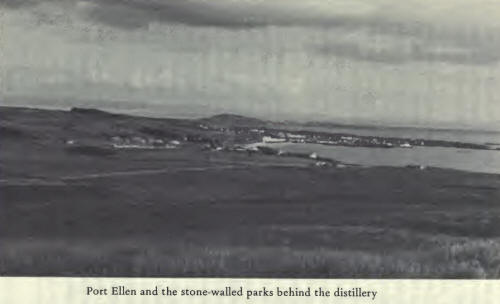
This was followed by an
even more detailed letter from George T. Chiene, Chamberlain of Islay.
enclosing the answers to queries set by Sir Edward Coffin, the
representative of the British government.
Some help was forthcoming but it was not sufficient, and the high road,
running at the foot of the hills across a great stretch of moorland
between Bridgend and Port Ellen, remained unfinished for many years. The
laird did succeed in obtaining a grant from the Enclosures
Conunissioners of £30,000, to be expended on land drainage within a
period of three years. Another necessary public work was the enlargement
of quays built for sailing vessels in order that steamers could be
accommodated, and Walter Frederick Campbell succeeded, also, in securing
an Act of Parliament for the erection of new harbour facilities at Port
Ellen. Just then, the failure of an Islay merchant whose bills he had
backed put the Campbell finances into such bad condition that the Estate
was sequestered, or removed from Mr. Campbell's possession, until the
demands of his creditors could be satisfied. The Trustees' accounts show
that the arrears of rent, carried on for many years, stood on December
2, 1847, at

At the request of Mr.
Campbell, his elder son, John Francis, (later to be famous as the editor
of the Popular Tales of the West Highlands) and John Ramsay acted as his
trustees throughout the period of the sequestration. James Brown, an
Edinburgh accountant, was chosen commissionar for the creditors and for
six years administered the estate, during which period there were a
number of enforced evictions, especially from the lead mining district
of Kilmeny. The Campbells retired to live in Avranches, in Normandy, but
John Ramsay and his widowed sister, Mrs. Miller, immediately offered to
adopt their younger son, Walter, and their third daughter, Violet, in
order that the children might at least be brought up in their own
country. Walter Frederick, however, declined the offer, saying that the
children were now all that was left to his wife and himself and that
they would strive to keep them. The whole family were forced to live in
very meagre circumstances and Mr. Campbell died in 1855.
Not until 1853 was a sale
effected to James Morrison of Basildon, in competition with James Baird
of Gartsherrie, at £451,000. Previous to the public roup (a sale
involving sealed bids) it had been agreed between James Morrison and
John Ramsay that if the former succeeded in purchasing the island, the
latter would relieve him of part of the parish of Kildalton, with an
option on the remainder at a later date. Thus by two missives
(contracting letters) dated May 9 and 15, 1855, John came into
possession of all lands lying north and east of Port Ellen Bay and east
of the line of the present high road from Port Ellen to Bridgend as far
as McArthur's Head on the Sound of Islay. In May, 1858, he bought the
lands which he held under lease and those immediately marching with
them. The total of these purchases being £82,265, plus, of course, the
various charges on the lands such as arrears of rent, money spent on
drainage, etc. The first purchase included Ardimersay Cottage situated
on a peninsula northeast of Port Ellen, a charming reed-thatched Regency
pavilion, which was to be John's much-loved home for many years.
Before catastrophe fell
upon him, Walter Frederick Campbell had encouraged John Ramsay to buy a
steamer for the purpose of running a cargo service between the islands
and Glasgow. This was the Modern Athens and from now on he owned or had
an interest in several boats and also in the fast sailing ships trading
with the East Indies. One unscheduled trip was made by the Modem Athens
when she was chartered to convey the men of Islay, Kintyre and Knapdale
to greet Queen Victoria at Inveraray in 1847. The County Committee
issued precise instructions.
It shall be the duty
of the Captain to exact a fare of ten Shillings and to admit no
person except those mentioned in the list furnished . . . the amount
of these fares to be deducted from the freight of the boat. Islay's
[i.e. Walter Frederick's] men or any other men dressed in Highland
Garb in attendance on County Gentlemen for the purpose of acting as
police not to be charged any fare.
Five hundred men in full
Highland dress are said to have gone from Islay alone.
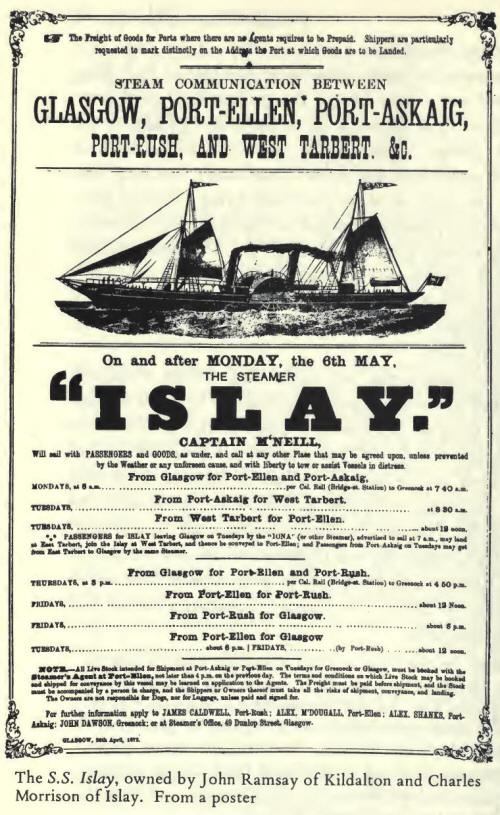
John's cargo boats went
as far north as Stornoway and the business thrived, but in 1855 he
withdrew from this northern trade and persuaded Charles Morrison, eldest
son of James of Basildon, to become half-owner of the Islay, a steamer
purchased by Walter Frederick Campbell for the benefit of the island, in
which several distillers had a share, John Ramsay's being the largest.
He then concentrated on a bi-weekly cargo and passenger service between
Islay and Glasgow, including calls at Port Rush in Northern Ireland and
West Loch Tarbert on the Argyll mainland.
During the sixties, when
John Ramsay was elected M.P. for the Stirling boroughs, there was a
sudden panic lest he be disqualified owing to his copartnership in the
Islay, which was in receipt of a yearly subsidy of £150 for carrying the
Royal Mail. The ownership of the boat was therefore transferred to
Charles Morrison, though John continued its management until they sold
in 1878 to David Hutcheson, the pioneer in daily steamship services to
the Western Isles (his boats were described in 1868 as "gorgeous
floating saloons"). Hutcheson was succeeded by his young partner, David
MacBrayne, whose name is now almost synonymous with the West of
Scotland.
Throughout the country at
this time there was much concern over the growth of pauperism and the
problem in Islay was causing great anxiety. Writing to Charles Morrison
of Islay (who had succeeded his father James) John says,
Assuming the
population to be 11,000 at this date (25th November 1859) the
Paupers on the Roll are 540, but this does not include the children
of the paupers who are supported from the Rates although their names
are not mentioned - this brings the actual number above 600. So that
in Islay instead ot one pauper for every twenty-three self
supporting members of Society [the National average] we have one
pauper for every sixteen self supporting members....
Under the Scottish Poor
Law Bill, passed in 1845, the three parishes of Islay had been united as
a Poor Law Combination (the only one in Scotland). Because communication
between the parishes was difficult, this was very soon found to be a
cumbrous and ineffective way of dealing with the problem and efforts
were made in 1848 and again in 1859 to dissolve the union, but it
appeared that there was no legal provision under the Act for such a
dissolution. This was not achieved until John finally consulted the Lord
Advocate for Scotland, who suggested that it could be accomplished by
parliamentary action. Mr. A.M. Dunlop, Member for Greenock agreed to
handle a bill for this purpose in the House of Commons and the Duke of
Argyll undertook to do the same in the House of Lords. Eventually the
three parishes were separated and thus enabled to deal more effectively
with the distressing problem within their own boundaries, before having
recourse to sending the individuals concerned to the poor house which it
was now proposed should be erected by the Poor Law Board. John Ramsay
asked that Charles Morrison, in gifting a site, should choose one
sufficiently near Bowmore, to allow the Superintendent of the Poor and
the minister to visit regularly, but above all to allow the children to
attend the village school so that they need not feel outcast by being
educated separately. This Charles did. The poor house (now demolished to
make way for the new hospital and home for the elderly) was built on the
edge of Bowmore, at Gartanvogie.
Since his first purchase
in 1855, John had pushed ahead with drainage and general improvements in
the hope that by so doing he could help to lift the mass of the tenants
out of the depths to which they had sunk. His letters to intimate
friends show how hopeless the task seemed to be, though he never fully
lost hope. At the end of five years as a landowner, he wrote to John
Stewart Hepburn of Colquhalzie,
I have completed the
drainage of above 200 acres near Port Ellen and have enclosed as
much of this with stone walls. I am going on with the drainage and
enclosure of about 60 acres which adjoin Coma- bus and I hope to
have nearly the half of it ready for turnips this season. My process
is to drain and enclose and then to get as great a breadth under
turnips as I have manure for, eat down the turnip crop with sheep on
the ground and then a crop of bere [barley] sown down with grasses
and let the land at the best rent I can get. I have found it needful
to lay out drainage improvements in the village of Port Ellen,
erecting a new female school and teachers dwelling and the
improvement of the farm houses of several of the tenants. In
consequence of the division of my outlay bearing a large proportion
to the gross expenditure, my rental has not increased so much as the
amount expended but I have now got past some of the most costly
work.....About the Cottage [Ardimersay] I have drained more extent
of moss land and cleared away part of the brushwood to make room for
the grass to grow, but the difficulty there is to exclude the deer
from the land under improvement . . . . . I have done nothing yet to
the property which I bought from Mr Morrison in 1858 - except
Cornabus it is all in the hands of small tenants and it is not easy
with them to even make a beginning. I am sorry to say I cannot
discern much improvement among the people. The villagers were very
poor when I got the property and some of them are now deeper in debt
than they were five years ago. I really do not know what to do with
them as they are helpless when the land is taken from them and
merely sink till they get on the Poor Roll . .
Charles Morrison now
approached him regarding the purchase of the rest of the parish of
Kildalton and Oa, but he was very reluctant to buy any more land and
suggested that possibly Smith Child, the banker, who had married Miss
Campbell of Jura and was looking for an estate in the area, might
consider this portion. Child wrote to John, asking whether he thought
that such a purchase would be "a good investment," to which John
replied,
I am not a good judge
of the Oa as an investment but from what I have heard I think it
probable that if people were removed and some improvements made on
the better part of the land, it could be made a good sheep grazing.
My views, however, regarding such removals are so much in unison
with your own that I could not like to meddle with any improvement
which involved the removal of any tenants. My feeling regarding the
place is that you might in time be able to get a considerable part
of the land into your own hands by taking advantage of the death of
any tenants and of voluntary emigration - but I am not of the
opinion that the rents in Islay will bear any such increase as in
Mull. Most of the land on my property is held without lease and I
believe I could get the tenants to promise me a considerable advance
were I to ask this with the alternative of leaving their farms, but
my anxiety is to see the tenants once in such circumstances as to
enable them to pay their present rents punctually and I fear that
either with or without leases it will be a long time before they are
in this state. One thing that I can say is that if you do buy the Oa
you will find the tenants, although poor, a very quiet inoffensive
race.
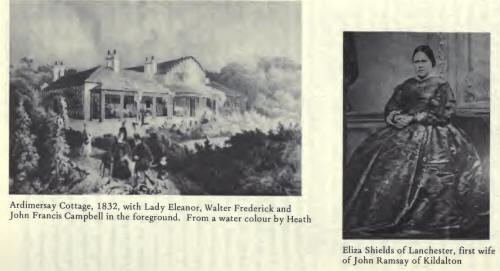
The fact of the matter
was that the thin-soiled peninsula of the Oa was vastly overpopulated
and its pockets of arable soil had become sour through improvishing
methods of cultivation. In 1839, three small farms in the central glen
housed eleven families with a total of seventy- five souls; in 1860 the
figures were seventeen families with a total of ninety-four people.
These farms today barely support three small families, aided by
government grants. The problem was enormous and letter after letter from
John Ramsay shows his great concern and sense of responsibility for the
welfare of the people on his estate.
Finally, Child purchased
a wedge of land based on the Sound of Islay, which is now the Dunlossit
estate, and from which the bulk of the small tenants had been evicted by
the Commissioner for Bankruptcy. At the same time, John Ramsay
reluctantly agreed to buy the Oa and Laggan under the same conditions as
on previous occasions, that is, relieving Charles Morrison of all
burdens on the land like arrears of rent, "excepting only the arrears of
the tenants of Upper and Lower Kileyan which will be settled by you
[Charles Morrison] as they leave at Whitsunday next."
These tenants were,
however, to prove difficult. Upper Killeyan is a small farm of
approximately 452 acres, mostly consisting of moor and bog, perched on
the three hundred foot cliffs of the Mull of Oa and exposed to all the
winds of the Atlantic. There were four tenants, who with their families
numbered twenty-nine souls, and they had all intimated to Charles
Morrison their intention to leave the island. On the understanding that
this farm was to be vacant at the date of his entry, John Ramsay
allocated it to a single tenant from another overcrowded farm. When, by
Whitsunday, 1861, the Killeyan tenants had not removed, Charles Morrison
said he would try to provide them with farms on his side of the island.
This, however, proved impossible and as the Kildalton Estate was already
so crowded, John Ramsay could not do so either. By May, 1862, they had
resolved to emigrate and being illiterate and only Gaelic-speaking, a
petition was drawn up on their behalf by the Reverend James Dewar,
minister of the Oa, which they signed by mark, asking Charles Morrison
for assistance to take them to Canada. This he gave and they sailed for
Toronto aboard the Damascus on June 28, 1862.
Provision for such
tenants was a matter of great concern and in his decision to purchase
the whole parish of Kudalton (which included the parish of the Oa) John
hoped to be able to make a fair trial of measures to arrest the increase
of pauperism and to bring some chance of prosperity to his tenants. To
Charles Morrison he wrote,
My possession of land
for the last few years has much modified the opinion which I at one
time entertained, as to the powers which its possession confers on
the holder to do good to the population. I entered in the possession
that as proprietor I might accomplish more than I could as tenant -
but I now have cause to doubt whether this has been realised in a
moral point of view and truly should the result prove that I am
unable to improve and benefit the people I will have altogether
missed my mark. I have not, however, as yet ceased to hope . . . I
hope you will not think of selling the rest of your property in
Islay, as your doing so would cause me much anxiety and regret . . .
it is not many of the Highland proprietors who direct their personal
attention to the moral and intellectual improvement of the people on
their land and were you to sell I should dread the risk of your
estate coming into the hands of one who would buy it only for sport
or profit and carry out plans in utter disregard of the interests
and feelings of the people.
Charles Morrison did not
sell any more land and in the difficult years to come the two men worked
in close harmony for the betterment of their estates and the tenants
thereon. Since the potato famine in the West of Scotland, John Ramsay
had given the problem of over population much thought and had
investigated various possible solutions. The conclusions he came to are
expressed in a paper, notable for its deep concern, thought and
research, which he read in Edinburgh to the National Association for the
Promotion of Social Science. Pointing out the disadvantage of a purely
Gaelic-speaking community, he said,
It is by some
erroneously supposed that the desire to promote instruction in
English implies an opposition to Gaelic. I do not admit this: no
comparison of the merits of the two languages is involved. Gaelic
may be the most ancient and by far the most expressive, but it is
undoubtedly true that a knowledge of both can be no bar to
improvement, and it is surely no disparagement to Gaelic to say that
a poor Highlander, who can only find employment where English is
spoken, should be taught to speak it.
He summed up his opinion,
that the cause of
periodical destitution in the Highlands, though varied by many
conflicting elements, has been the excessive dependance of the
people upon the produce of the soil, and the lack of sufficient
application and effort to procure supplies from other sources for
the increase in their number: and if so the remedy as plainly
appears to be the local development of industry, so as to provide a
greater supply of remunerative employment: the removal of obstacles
which hinder people in their efforts to help themselves - the
promotion for increased facilities for intercourse with the
mainland: the aid and encouragement of spontaneous migration: and
chiefly and above all and with a view to attain all, the diffusion
of the blessings of a sound English education.
With all this in mind,
Ramsay did persuade many small communities, especially in the Oa, to
emigrate to Canada as entities, believing that the future there held out
much for the younger people and that as their elders would not be
separated from them, they would not feel the uprooting quite so
poignantly. For those who did decide to emigrate he made things as easy
as possible: arrears of rent were cancelled, their stock was bought in
order to give them ready cash, and arrangements were made with the Allan
Steamship Company for much reduced fares on steamers, which were a great
advance on the old decrepit sailing ships in which so many earlier
emigrants had journeyed. John Ramsay was prepared to pay the fares if
necessary, but the bulk of the emigrants paid their own fares or
refunded them to John when in a position to do so.
The Reverend John
MacTavish, son of the parish minister and member of a family famous in
the annals of Argyll and Canada, was minister at Woodville, Ontario, in
the area in which so many Islay folk were to make their homes and where
earlier emigrants of the thirties and forties had already settled. He
was ready to help them on their arrival, not only with their spiritual
needs but also with material necessities, particularly those lacking or
with very little knowledge of English, who might so easily have fallen
prey to adventurers.
The emigration facilities
were extended to the whole island and Charles Morrison and Smith Child
backed those who wished to emigrate, in the same manner as John Ramsay.
The organisation of emigrants from the parish of Kilmeny was in the
hands of Charles MacNeil, of an old Islay family, who also had relatives
in Canada and knew the advantages to be reaped there. The following is a
letter from him to John Ramsay.
Lossit, Islay.
13th July 1863.
My dear Sir,
It was very kind of
you to write to me on the subject of the emigrants from this
quarter, who I hope will all be in readiness to start tomorrow, that
is, so many of them as are in a condition to go. I have explained to
them the necessity of attending to all the rules for their guidance,
and hope they will comply with them. I expect that Mr Shanks will
accompany them to Greenock which will be a great boon to the poor
creatures, many of whom never left Islay, and are quite ignorant of
what they ought to do in their new position; only that their desire
to get to Canada is unprecedently great, and they wish to get away
at all hazards while the facilities are afforded them, and I would
like to see many more of them remove for their own sakes for last
Winter and Spring was a severe ordeal to them in many respects, and
they anticipate no better fate during the ensuing season, should
they remain as at present. They are fortunately meeting with good
weather which will cheer them on their way and I have no doubt that
they will also meet with good treatment, which will perhaps induce
the friends they left behind to wish to follow them next season. . .
This emigration of about
four hundred Islay people during the years 1862-3 brought a spate of
angry or sarcastic letters to the press, written over nom de plumes.
They were thought to come largely from Islaymen long settled comfortably
in Glasgow, who accused John Ramsay of "enforced removals". Many years
later when the Crofters' Act was brought forward, the howl was raised
again. It is still fashionable, on both sides of the Atlantic, to
believe that all emigrants were forcibly removed from their holdings and
that emigration was not only a sad, but also a disastrous affair for
them. This is by no means true. A very great number of Highlanders,
realising the gravity of their circumstances, emigrated voluntarily,
although they were unhappy to leave their native land. One fact,
however, stands out above all: that those who did emigrate, whether
voluntarily or not, benefited themselves and their descendants, despite
the initial hardships, in a way which would have been impossible for
them in their lovely, rugged, overpopulated and unprofitable homeland.
Among much
correspondence, there is one particular letter from an Islayman -
Alexander Bell, of Sunnidale Corner, Ontario - who had emigrated
voluntarily in 1843, and revisited Islay in 1883. Mr. Bell writes with
admiration of the change wrought by John Ramsay during the intervening
years and, referring to the outburst in the press against him, has
little good to say of his critics, "people who think they can manage
very well other people's business, though they cannot manage their own".
John, himself, made a very effective speech in the House of Commons [Hansard
14.11. 1888], drawing on his long and intimate knowledge of the
situation. He sincerely believed that voluntary emigration to Canada (as
opposed to migration to other parts of Britain) was the right solution
to Islay poverty and lack of opportunity, and was more than ever
convinced of this when he visited the Islay people in their new homes in
1870 for the purpose of satisfying himself that they were, in fact,
doing well.
His diary of this visit,
which is now published for the first time (though it was privately
printed for distribution among interested friends), relates what he saw
and what he heard from the emigrants themselves, as to how they had
burgeoned in a manner which would have been impossible in Islay so long
as the population had remained so thick upon the land. He noted with
pleasure and some surprise how, once removed from the clan aura, they
worked willingly for wages in the summer, thus providing themselves with
capital to clear their holdings in the winter, sow their crops the
following spring, and regularly pay off the price of their farms. He
saw, too, how much the women's housewifery had progressed from the kail
pot and bannocks to the baking of real bread of wheaten flour (wheat
does not ripen readily in Islay), and contrasted the neat, bright
cleanliness of their Canadian houses with the mud-floored, turf-roofed
dark cottages, veiled in peat reek, which seemed to crouch against the
wind and rain of the Atlantic gales. The older people did complain of
the bitter winters, but nevertheless, they had settled well, had all the
necessities of life, and were glad to see their families prospering and
to be with them.
John brought his bride,
Eliza Shields of Lanchester, to Ardimersay in 1857. She was a gentle
creature with a particular interest in the spread of education, a matter
very close to John's heart. Together they travelled through the Western
Islands, visiting and founding schools as far north as Lewis. A
published letter of John's to the Lord Advocate of Scotland, "The State
of Education in the Outer Hebrides, 1862," is informative, detailed,
sympathetic and constructive. In Islay, educational facilities were
perhaps better than elsewhere in the islands. In the early years of the
century, Walter Frederick Campbell and his uncle Walter Campbell of
Sunderland had done much to establish efficient schools, a policy
continued by John Ramsay and Charles Morrison. To begin with, the
buildings were much superior, the Campbells having laid down that new
cottages should have walls of stone and lime (not the old dry stone
construction) and these must be a certain height to the eaves, "having
gabled ends with built-in chimneys in the English manner, the roofs to
be slated". Though few of the roofs complied with this last provision,
the new cottages, which included the schools, were a great improvement
on the so-called black houses, such Hebrides cottages as John Francis
Campbell described vividly in 1860:
built of a double
wall of loose boulders, with a layer of peat three feet thick
between the walls, the ends round, and the roof rests on the inner
walls, leaving room for a crop of yellow gowans [corn marigolds]. A
man might walk round the roof on top of the wall. There is but one
room with two low doors, one on each side of the house. The fire is
on the floor; the chimney is a hole above it; and the rafters are
hung with pendants and festoons of black peat reek. They are of
birch . . . American drift wood, or broken wreck. They support a
covering of turf and straw, and stones and heather ropes, which keep
the rain out well enough. .
Such a cottage in Islay
figures as an illustration to Pennant's Tour In Scotland, published in
the 1770's, but of these there were comparatively few left in Islay
during the nineteenth century.
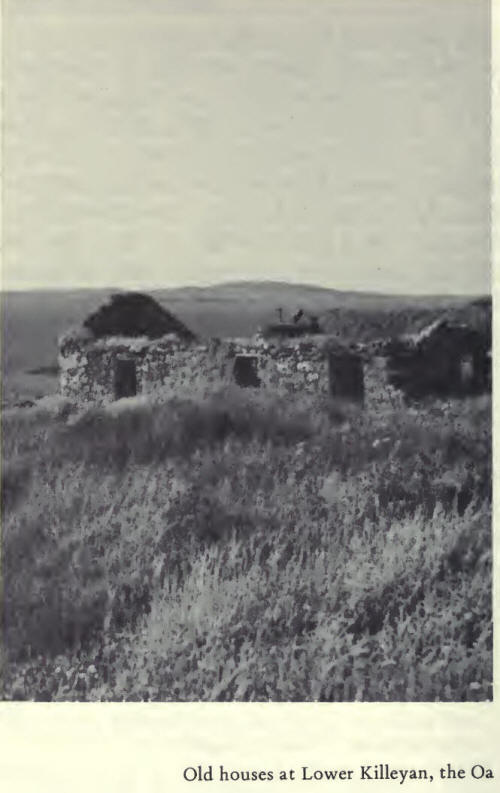
It will, however, be
readily understood that though picturesque, they were not suitable for
the upbringing of large families nor for educational establishments. It
is not to be wondered that tuberculosis was so prevalent and it was the
knowledge that this and other ills were on the increase that gave rise
to the anxiety of thinking men. The bulk of the inhabitants were
undoubtedly of high intelligence and many, as Dr. Arthur Mitchell wrote,
"have a potential though undeveloped greatness". One fact emerges
throughout history: that the latent abilities of the Highlander are more
fully developed when he leaves his mountain and island fastnesses for
the outer world.
In providing the spur of
education in Islay, the greatest difficulties lay in the lack of roads
and means of transport. This meant that a disproportionate number of
schools had to be provided for what was, in effect, a littoral
population. There is a list of Islay schools visited by John Ramsay in
December and January 1860-61 numbering twenty-nine, with an enrolled
total of 1,519 pupils. In the parish of Kildalton there were ten schools
(four of them in the Oa); two more seem to have been temporarily closed
at that time. The original village school in Port Ellen, founded by
Walter Frederick Campbell, together with the Free Church School and the
Female School, were finally incorporated in the present on built by the
school board. There was much dissension regarding its site, given by
John Ramsay. He argued that a rocky promontory, central to the village
and swept by the clean sea breezes, was a healthier place than a boggy
field behind the village, in close proximity to its privies and garbage
heaps. A new school was also built at Risabus in the middle of the Oa.
The remaining schools were replaced by those at Kintour, Glenegedale
lots (both of which have been closed since World War II) and Ardbeg, all
erected by John and Eliza Ramsay. Even though several of the schools
were supported by a church or society, the onus of finding suitable
schoolteachers and paying their salaries long fell upon John, and there
is an immense correspondence on the matter among the Kildalton Papers.
On three different occasions, (1869, 78, 82) John was appointed to a
Royal Commission on Scottish Education, and as an M.P., he shepherded
the Scottish Education Bill through Parliament.
It was Eliza who
introduced the stand pumps into the village of Port Ellen so that the
inhabitants would not need to carry their water half a mile from Tober
Main. To the fury of her husband, the people threw rubbish into the
wells which fed the pumps and continued to fetch their water from the
distant spring. During the next decade there were those who accused John
Ramsay of not having supplied the village with water!
Eliza died in Glasgow in
1864 of what we now know to have been appendicitis, but at the time the
surgeons had not discovered the saving operation. Her plan to build a
modern school and teacher's house above Ardbeg, to replace the old one
at Lagavulin, was carried out by John after her death. Charles Morrison
designed the memorial tablet of Islay blue stone on the porch gable. The
building is on a knoll, on which trees were planted, with a view over an
archipelago of rocky islets to the long line of the Kintyre peninsular
and the jagged peaks of the Isle of Arran.
Lonely and dispirited,
plagued by mudslingers, one of the chief of whom was John Morrison, late
of Port Ellen and Ardinistle Distilleries, to whom he had finally to
write a very straight letter, John nevertheless pulled himself together
and continued the work that he and Eliza had done so much to forward.
Ramsay was asked to stand
as Member for Glasgow in 1866, but was defeated. Two years later he was
returned for the Stirling boroughs, only to be defeated by his previous
opponent, Henry Campbell (later to be Sir Henry Campbell-Bannerman and
Prime Minister), at the ensuing general election. In 1874, however, he
again entered Parliament as the Member for the Falkirk boroughs, a seat
he held until his retirement in 1885. In particular he piloted the
Scottish Education and Scottish Lunacy Bills, both matters of especial
interest to him, the latter being largely the work of his great friend,
Sir James Cox, and his cousin, Dr. (afterwards Sir) Arthur Mitchell. In
1869, he was elected president of the Glasgow Chamber of Commerce and as
such was invited by the viceroy of Egypt to attend the opening of the
Suez Canal. Among the Kildalton Papers there is another diary covering
this momentous event.
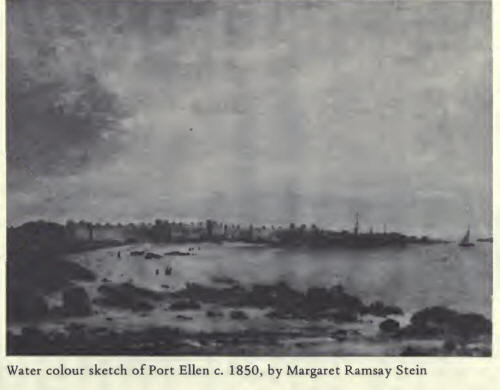
Ardimersay Cottage proved
difficult to keep weatherproof, although John replaced the thatch with
slates. He, therefore, built the present Kildalton House in 1870, to
which he brought his second wife, Lucy, daughter of George Martin of
Auchendennan (now the Loch Lomond Youth Hostel). Although very much
younger than he, she supported him in all his public activities and was
the mother of his three children.
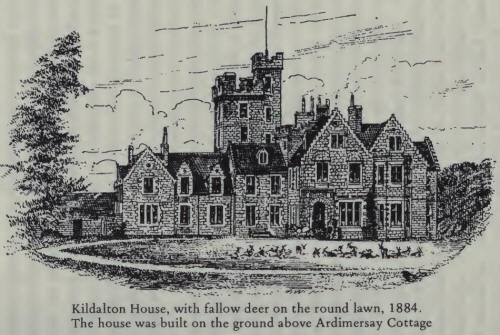
In Islay, he continued to
improve the estate, building over twenty farm houses and steadings,
designed on the square plan and constructed for the most part of dressed
stone, with water laid on and sanitation. He completed the high road,
Charles Morrison doing the shorter length on his ground, and built the
low road across the eight- mile stretch of Laggan Moss to connect Port
Ellen directly with Bowmore; floating it on birch faggots over the deep
peat, and draining lochs where necessary. He encouraged good husbandry
and also the cod fishing, which had become the mainstay of Portnahaven
and Port Wemyss. As a Free Churchman, he had built the Free Church and
manse in Port Ellen in 1848 and now, ironically, he found himself sole
heritor of Kildalton parish and required to build a new manse for the
Established Church in 1861. He also improved the quay accommodation at
Port Ellen.
In the last decades of
the century, farming reached its zenith in Islay. The quality of the
dairy herds of Ayrshire cows was high and many farms had lofts for
several hundred cheeses of the Dunlop type, which fetched high prices on
the London market. Sheep and beef cattle were also of a high standard
and the farms were well cultivated. Between distilling (until Ardinistle
was closed there were five distilleries in the parish) and agriculture,
Kildalton was now a thriving district.
During his visit to
Canada, John had been much impressed by the convenience of Mr. Allan's
steam yacht on Lake Memphremagog and determined to have one for himself.
In due course he purchased The Lancer and thus equipped he and Lucy were
able to visit many places on the west coast of Scotland that were
otherwise very difficult of access. As he grew older, he was advised by
his doctor to spend the more trying months of the winter in the south of
France, where the yacht was also a very great pleasure to him.
The mainland estate of
Woodhall, belonging to the Shawfield Campbells, was sold in 1859 and the
contents were to be auctioned in Edinburgh. In his capacity as trustee,
John went down to the house to supervise the removal, and on his
arrival, found that the books had already been removed from the
bookcases for packing and that the contents of the library drawers, "old
papers," had been emptied onto the floor. Looking at them carefully, he
discovered that not only were there the old factory papers of the first
Daniel Campbell of Shawfield's merchandising ventures, but also the
charter of Islay (1606) and many eighteenth century papers relating to
the island. These he collected up, sending the factory papers and
personal letters to John Frances Campbell. The former have since been
purchased by the Mitchell Library in Glasgow, but the whereabouts of the
latter is at present unknown. In the years that followed, having kept
all the papers relating to Islay, he sorted and arranged them, enlisting
the interest of his friend Cosmo Innes, Professor of Legal History at
Edinburgh University. It was obvious that these papers covered a great
deal of the history of the island but it was not until after his death
that his widow placed them in the hands of Gregory Smith, a noted
historian of the day. Mr. Smith went further afield to find related
documents, thus compiling a very complete source book, The Book of Islay,
which was published at Lucy's expense. This valuable book is now almost
unobtainable, but a most excellent prÍcis of it has been published
recently by Dr. W. D. Lamont of Glasgow University, entitled The Early
History of Islay.
The eighteenth century
was considered too near in time to warrant a history so the remaining
papers were divided according to their application between the estates
of Kildalton and Islay House. They form the basis of a book now in
preparation by the present author.
Lucy Ramsay also
transcribed and published The Stent Book of Islay, being the minutes of
the local committee of the laird and tacksmen, which met once a year to
discuss and carry out public affairs. This record covers a period of
nearly a century and a quarter.
Both husband and wife had
been greatly interested in the preservation of the antiquities of the
island and, among other activities, had reset the magnificent Cross of
Kildalton, which was standing at a perilous angle. The operation was
supervised by Sir Arthur Mitchell, President, Dr. Joseph Anderson,
Secretary of the Scottish Society of Antiquaries, and the staff of the
Museum of Antiquities in Edinburgh. Later, Lucy encouraged R.C. Graham
to produce his beautifully illustrated book The Carved Stones of
Islay.
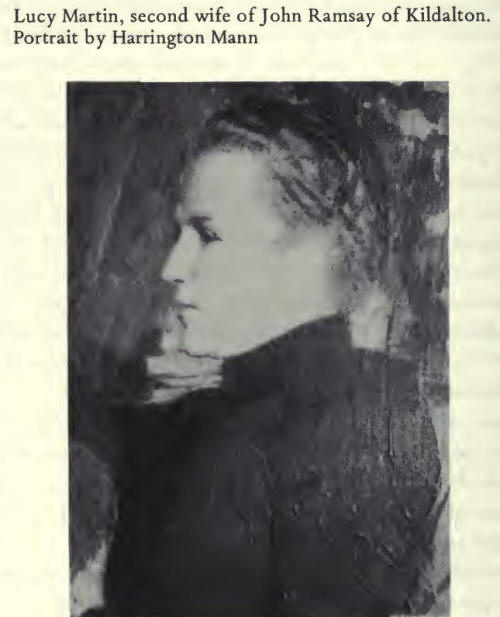
The diary ends with John
Ramsay's visit to New York where he saw his cousins, the Christies, and
called upon his business associates in that city. The American Civil War
had adversely affected his whisky sales. These were now recovering but,
in any case, he was no longer entirely dependent on the proceeds of the
distillery, having expanded his business interests in Glasgow. On his
way he visited and photographed Niagara Falls before sailing once more
for Islay.
Almost sixty years after
he had taken up his work at Port Ellen Distillery - years of incessant
work in many fields - John Ramsay died peacefully in his library chair
at Kildalton, on January 24, 1892, at the age of seventy- seven. He was,
as Professor Blackie wrote of him "a man of large intelligence and
practical good sense," with a deep love of Scotland and his countrymen,
held in respect and affection by his fellow citizens of Glasgow, his
political colleagues of all parties and a very wide circle of friends.
Linlithgow had conferred her freedom upon him; his native city of
Stirling elected him a Hammerman; the City of Glasgow made a
presentation of gold plate in recognition of his services to her, and in
1882, he was appointed Her Majesty's Deputy Lieutenant of Argyll. All
through Huronia and the townships northeast of Lake Simcoe it is
possible to see fine farms, with the delightful houses which succeeded
the log cabins, still occupied by descendants of the men and women with
whom John Ramsay talked during his visit. Many of the younger
generations have spread across the length and breadth of North America
and the prosperity and happiness they have created for themselves is the
finest memorial John Ramsay could have wished.
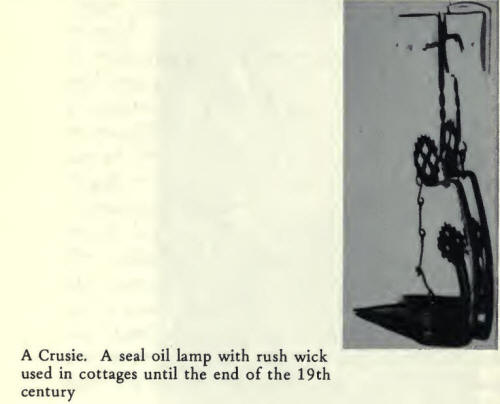
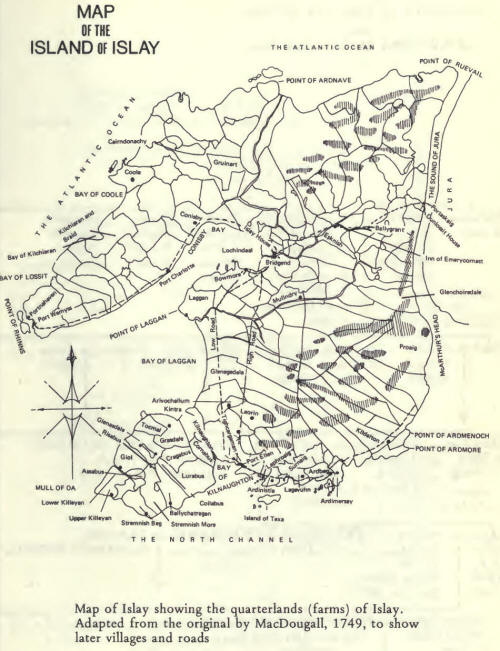
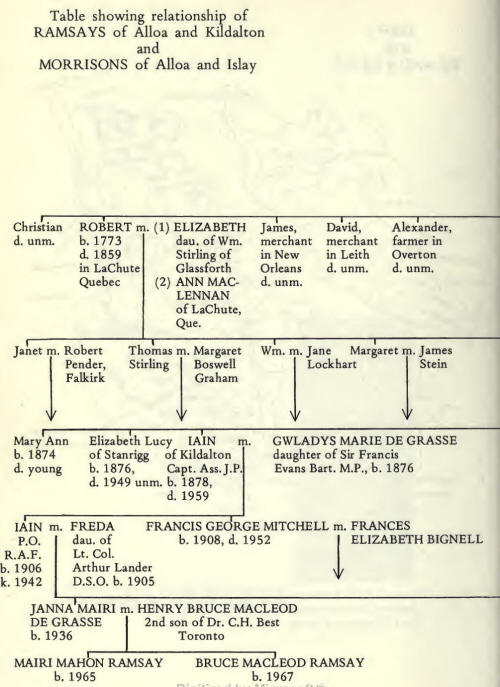
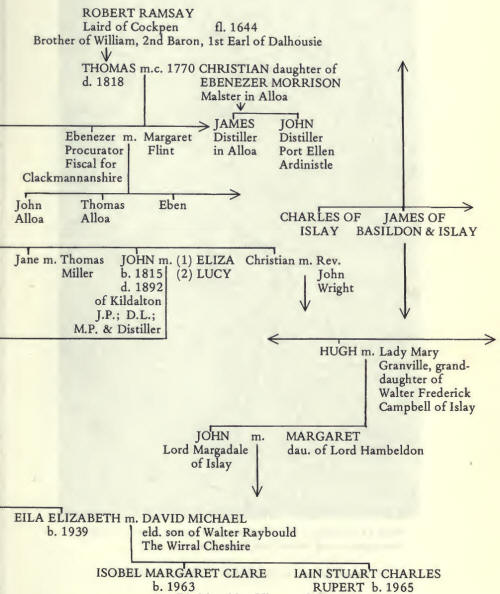
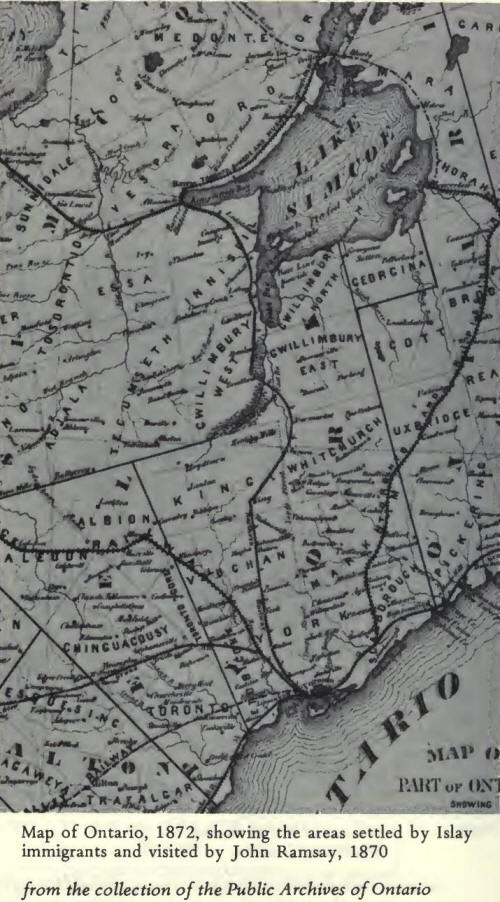 |

